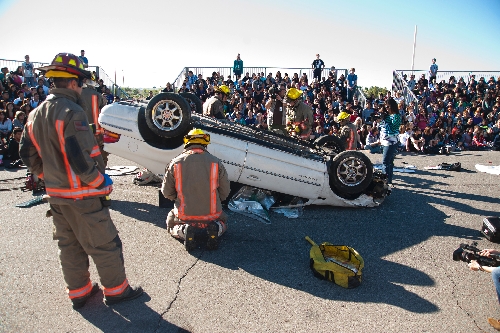Teens see drinking, driving lessons
At age 17, Tyler Cross was too young to lie dead on the street, part of his brain splayed on the asphalt.
At age 17, Curtis Hadland was too young to be pronounced dead in the emergency room of University Medical Center after a Flight for Life transport.
At age 16, J'Nissi Johnson was too young to suffer, among other injuries, a 4-inch cut so deep and so wide to her face that she will carry a scar - emotional as well as physical - for the rest of her life.
At age 18, Angelo DeSantis was too young to spend the next 60 years of his life in prison.
This story, intricately manufactured but so real in its depiction, played out at Silverado High School late last week as the Metropolitan Police Department presented "Every 15 Minutes," a two-day program for high school seniors and juniors that teaches the life-changing and often life-ending consequences of drinking and driving. The program is based on the 1980s statistic that every 15 minutes someone nationally was killed in an alcohol-related accident.
From the frantic 911 call played over a public-address system to first-to-arrive Las Vegas police officers assessing the scene and arresting the drunken driver, from Clark County Fire Department members using the Jaws of Life to extricate one teen from an overturned compact and airlift him to the hospital to the coroner's office body-bagging the dead teen on the pavement, from the reading of two powerful obituaries to the funeral-quiet response those words received from an assembled audience of 1,100, what played out Thursday morning in front of the school on Silver Hawk Avenue was high drama.
But it was nothing compared to what played on video Friday morning for those same seniors and juniors inside the school's gym. There, a day after they had the chance to discuss the "accident" with classmates and family, the students witnessed the emotional aftermath: parents at the hospital being told of their son's death, parents at the morgue identifying their son's body, a young man found guilty of felony DUI causing death and substantial bodily harm and sentenced to three consecutive 20-year prison terms.
"This program goes straight to them, the new drivers and the soon-to-be adults - out on their own, soon going to college, having a lot of these decisions they need to make and hopefully making the right decisions," said police officer Kelly Raybuck, the local "Every 15 Minutes" program coordinator. "We don't get through to everybody, but we do get through to some."
"In fact," she added, "if we get just two or three, that's two or three deaths our fatal team doesn't have to go out on. That's hundreds of people who don't have to go to a funeral and have their lives affected by losing a loved one."
The cost of staging the event is approximately $80,000, and it's presented at four Clark County School District high schools each year. Seniors and juniors are targeted because their driving years are just beginning and they regularly face peer pressure to drink.
While it would be impossible to quantify what success programs such as "Every 15 Minutes" have on reducing drunken driving among teens, recent statistics provided by the Centers for Disease Control and Prevention say the number of teens who drink and drive has fallen by 54 percent over the past two decades. Two reasons cited by the federal agency's Morbidity and Mortality Weekly Report was the implementing and strengthening of laws to curb underage alcohol consumption and higher gasoline prices that are keeping some teens off the road.
In 2011, 10 percent of high school students reported drinking and driving, compared with 22 percent in 1991, the report said. People ages 16 to 20 are 17 times more likely to die in a crash when their blood-alcohol level is 0.08 percent, the legal limit in many states.
But did last week's program have any impact on Silverado's teens? It depends upon whom you ask.
Senior Brandon Zachry was impressed with the presentation. He admitted to being someone who tempted the fates by drinking and driving in the past but has given up drinking "because my point of view about it has changed."
"It'll have an impact on some kids," Zachry said, "but I think a lot of kids are going to say it's not a big deal. They're going to say, 'I'll just do as I do.' "
Anna Campbell, a junior, said she was hopeful the program would provide a lasting message for her friends. She said to not acknowledge the danger of drinking and driving, especially after having had it laid out for them so dramatically, would be foolish.
"A death is a death. It's one less person. You know that person was loved by many," she said.
But perhaps the most powerful answer came from DeSantis, the scripted drunken driver who was led away in handcuffs in front of his school mates. He later went through the police booking process, as well as being mock-sentenced before a judge.
"I play sports here, so a lot of people know me," he said, noting that he volunteered to play the antihero role of the teen tragedy. "I want to show that you could kill someone, end someone's life, by drinking and driving. I want this to make a huge impact on a lot of people."
It would be difficult to believe that the in-your-face presentation didn't at least catch the attention of every teen who watched it play out. It would be difficult to believe that the next time a teen drinks - and yes, parents, many of your teens do - they won't at least stop to think about driving or getting into a car with another teen who has.
Which brings us back to "convicted" teen drunken driver DeSantis. Asked if in real life he has ever tempted fate by drinking and driving, he sits up straight and replies, "I have not. I know better."
If only that was the case for every teen.
Questions and comments should be sent to roadwarrior@reviewjournal.com. Please include your phone number. Follow the Road Warrior on Twitter: @RJroadwarrior.
■ Detour of eastbound traffic on Sahara Avenue at Boulder Highway running through March for storm drain construction project.
■ Lane closure on westbound Tropicana Avenue, between Paradise Road and Koval Lane, from 9 tonight to 5 a.m. Monday for drainage structure repairs.
■ Disruptions on Buffalo Drive, between Lake Mead and Charleston boulevards, through late October for road improvements.
■ Lane closure on Shadow Lane, between Alta Drive and Charleston Boulevard, through Oct. 31 for utility work.
■ Lane closure on Paradise Road, from Royal Moon Avenue to Robindale Road, Monday through Nov. 23 for Water Reclamation District survey.
■ Lane closure on McLeod Drive, from Sunset Road to Patrick Lane, Monday through Nov. 23 for Water Reclamation District survey.
■ Lane closure on Lamb Boulevard, from Oquendo Road to Hacienda Avenue, through Nov. 2 for Water Reclamation District survey.
■ Lane closure on Nellis Boulevard, from Hacienda Avenue to Flamingo Road, through Nov. 2 for Water Reclamation District survey.
■ Lane closure on Hacienda Avenue, from Lamb Boulevard to Grapevine Springs Park, through Nov. 2 for Water Reclamation District survey.
■ Night lane closure on Sunset Road, from Eastern Avenue to McLeod Drive, through Nov. 2 for Water Reclamation District survey.
■ Night lane closure on Warm Springs Road, between Tamarus Street and Eastern Avenue, through Nov. 2 for Water Reclamation District survey.
■ Night lane closure on Spencer Street, from Warm Springs Road to Eldorado Lane, through Nov. 2 for Water Reclamation District survey.
■ Lane restrictions on both directions of Decatur Boulevard, between Lake Mead Boulevard and Rancho Drive, through Nov. 30 for paving and median island improvements.
■ Delays on Jones Boulevard from U.S. Highway 95 to Sahara Avenue for widening.
GASOLINE PRICES
The average price of gasoline Friday in the Las Vegas Valley was $3.82 per gallon; the state average was $3.92; the national average was $3.71.
LAS VEGAS REVIEW-JOURNAL




























